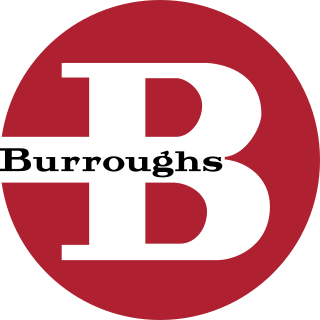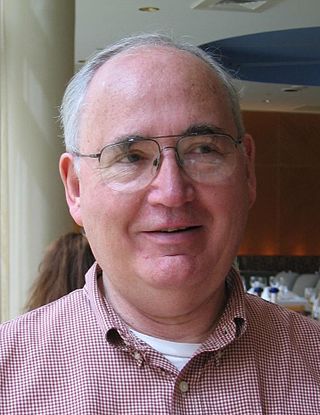Related Research Articles

The Burroughs Corporation was a major American manufacturer of business equipment. The company was founded in 1886 as the American Arithmometer Company by William Seward Burroughs. In 1986, it merged with Sperry UNIVAC to form Unisys. The company's history paralleled many of the major developments in computing. At its start, it produced mechanical adding machines, and later moved into programmable ledgers and then computers. It was one of the largest producers of mainframe computers in the world, also producing related equipment including typewriters and printers.
A disk operating system (DOS) is a computer operating system that resides on and can use a disk storage device, such as a floppy disk, hard disk drive, or optical disc. A disk operating system provides a file system for organizing, reading, and writing files on the storage disk, and a means for loading and running programs stored on that disk. Strictly, this definition does not include any other functionality, so it does not apply to more complex OSes, such as Microsoft Windows, and is more appropriately used only for older generations of operating systems.
Control Data Corporation (CDC) was a mainframe and supercomputer firm. CDC was one of the nine major United States computer companies through most of the 1960s; the others were IBM, Burroughs Corporation, DEC, NCR, General Electric, Honeywell, RCA, and UNIVAC. CDC was well-known and highly regarded throughout the industry at the time. For most of the 1960s, Seymour Cray worked at CDC and developed a series of machines that were the fastest computers in the world by far, until Cray left the company to found Cray Research (CRI) in the 1970s. After several years of losses in the early 1980s, in 1988 CDC started to leave the computer manufacturing business and sell the related parts of the company, a process that was completed in 1992 with the creation of Control Data Systems, Inc. The remaining businesses of CDC currently operate as Ceridian.

Engineering Research Associates, commonly known as ERA, was a pioneering computer firm from the 1950s. ERA became famous for their numerical computers, but as the market expanded they became better known for their drum memory systems. They were eventually purchased by Remington Rand and merged into their UNIVAC department. Many of the company founders later left to form Control Data Corporation.

The IBM 7030, also known as Stretch, was IBM's first transistorized supercomputer. It was the fastest computer in the world from 1961 until the first CDC 6600 became operational in 1964.

Dana Stewart Scott is an American logician who is the emeritus Hillman University Professor of Computer Science, Philosophy, and Mathematical Logic at Carnegie Mellon University; he is now retired and lives in Berkeley, California. His work on automata theory earned him the Turing Award in 1976, while his collaborative work with Christopher Strachey in the 1970s laid the foundations of modern approaches to the semantics of programming languages. He has also worked on modal logic, topology, and category theory.
The Cyclone is a vacuum-tube computer, built by Iowa State College at Ames, Iowa. The computer was commissioned in July 1959. It was based on the IAS architecture developed by John von Neumann. The Cyclone was based on ILLIAC, the University of Illinois Automatic Computer. The Cyclone used 40-bit words, used two 20-bit instructions per word, and each instruction had an eight-bit op-code and a 12-bit operand or address field. In general IAS-based computers were not code compatible with each other, although originally math routines which ran on the ILLIAC would also run on the Cyclone.

Leslie B. Lamport is an American computer scientist and mathematician. Lamport is best known for his seminal work in distributed systems, and as the initial developer of the document preparation system LaTeX and the author of its first manual.

The history of computing hardware starting at 1960 is marked by the conversion from vacuum tube to solid-state devices such as transistors and then integrated circuit (IC) chips. Around 1953 to 1959, discrete transistors started being considered sufficiently reliable and economical that they made further vacuum tube computers uncompetitive. Metal–oxide–semiconductor (MOS) large-scale integration (LSI) technology subsequently led to the development of semiconductor memory in the mid-to-late 1960s and then the microprocessor in the early 1970s. This led to primary computer memory moving away from magnetic-core memory devices to solid-state static and dynamic semiconductor memory, which greatly reduced the cost, size, and power consumption of computers. These advances led to the miniaturized personal computer (PC) in the 1970s, starting with home computers and desktop computers, followed by laptops and then mobile computers over the next several decades.
Laurie Spiegel is an American composer. She has worked at Bell Laboratories, in computer graphics, and is known primarily for her electronic-music compositions and her algorithmic composition software Music Mouse. She also plays the guitar and lute.

The history of computing is longer than the history of computing hardware and modern computing technology and includes the history of methods intended for pen and paper or for chalk and slate, with or without the aid of tables.
Fabless manufacturing is the design and sale of hardware devices and semiconductor chips while outsourcing their fabrication to a specialized manufacturer called a semiconductor foundry. These foundries are typically, but not exclusively, located in the United States, China, and Taiwan. Fabless companies can benefit from lower capital costs while concentrating their research and development resources on the end market. Some fabless companies and pure play foundries may offer integrated-circuit design services to third parties.

Martin David Davis was an American mathematician and computer scientist who contributed to the fields of computability theory and mathematical logic. His work on Hilbert's tenth problem led to the MRDP theorem. He also advanced the Post–Turing model and co-developed the Davis–Putnam–Logemann–Loveland (DPLL) algorithm, which is foundational for Boolean satisfiability solvers.

PLATO, also known as Project Plato and Project PLATO, was the first generalized computer-assisted instruction system. Starting in 1960, it ran on the University of Illinois's ILLIAC I computer. By the late 1970s, it supported several thousand graphics terminals distributed worldwide, running on nearly a dozen different networked mainframe computers. Many modern concepts in multi-user computing were first developed on PLATO, including forums, message boards, online testing, email, chat rooms, picture languages, instant messaging, remote screen sharing, and multiplayer video games.

Robert Stanley "Bob" Barton was the chief architect of the Burroughs B5000 and other computers such as the B1700, a co-inventor of dataflow architecture, and an influential professor at the University of Utah.

Joseph Amadee Goguen was an American computer scientist. He was professor of Computer Science at the University of California and University of Oxford, and held research positions at IBM and SRI International.

The CDC 3000 series are a family of mainframe computers from Control Data Corporation (CDC). The first member, the CDC 3600, was a 48-bit system introduced in 1963. The same basic design led to the cut-down CDC 3400 of 1964, and then the 24-bit CDC 3300, 3200 and 3100 introduced between 1964 and 1965. The 3000 series replaced the earlier CDC 1604 and CDC 924 systems.
Patrick Colonel Suppes was an American philosopher who made significant contributions to philosophy of science, the theory of measurement, the foundations of quantum mechanics, decision theory, psychology and educational technology. He was the Lucie Stern Professor of Philosophy Emeritus at Stanford University and until January 2010 was the Director of the Education Program for Gifted Youth also at Stanford.

Hideki Matsutake is a Japanese composer, arranger, and computer programmer. He is known for his pioneering work in electronic music and particularly music programming, as the assistant of Isao Tomita during the early 1970s and as the "fourth member" of the band Yellow Magic Orchestra during the late 1970s to early 1980s.
References
- ↑ Stuart, LaFarr. "My Forth and Mathematical Stuff". Zyvra.org. Retrieved 2020-03-30.
- ↑ Brodie, Leo (27 December 2004). Thinking Forth. Punchy Publishing. ISBN 9780976458708 . Retrieved 2020-03-30.